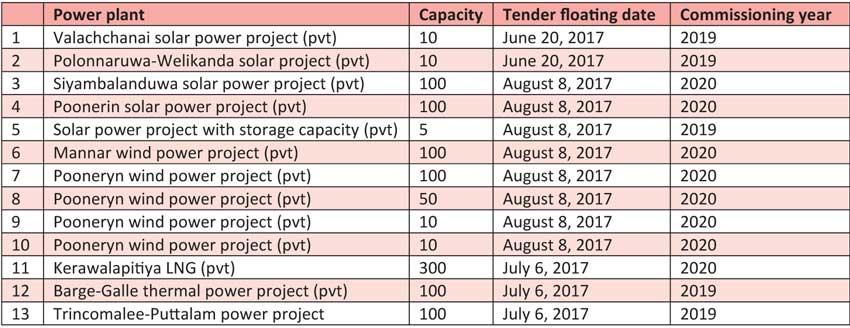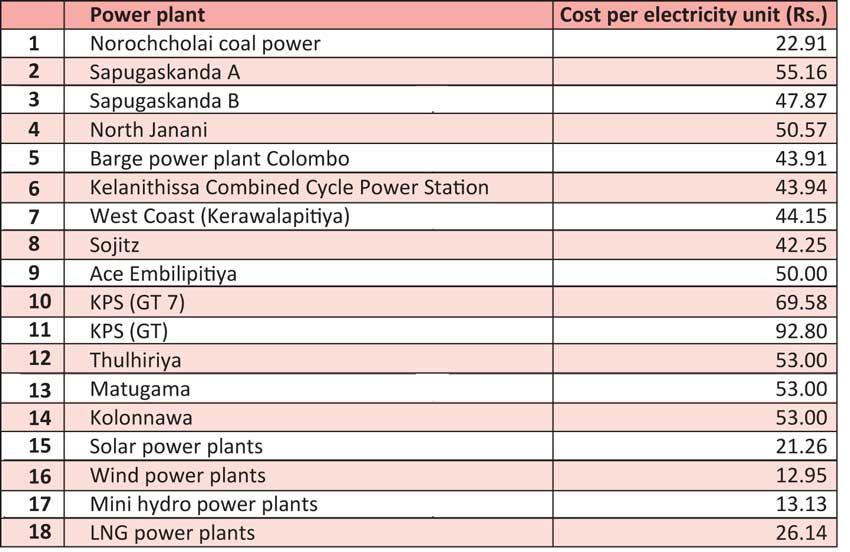07 Apr 2022 - {{hitsCtrl.values.hits}}
 When the lights went out on March 31 many Sri Lankans would hardly have been surprised. Rationing of electricity has grown commonplace in recent years, particularly since March of this year, when a foreign currency shortage produced a fuel crisis and reservoir levels fell owing to dry weather.
When the lights went out on March 31 many Sri Lankans would hardly have been surprised. Rationing of electricity has grown commonplace in recent years, particularly since March of this year, when a foreign currency shortage produced a fuel crisis and reservoir levels fell owing to dry weather.
The Government has offered a variety of explanations for the blackouts, ranging from dollar shortage to COVID-19 pandemic. In fact, the pandemic interrupted economies of many countries. However, evidence shows that Sri Lanka’s power problem is the result of more than a decade of corruption and inept power system management.
Analysts anticipate that a global shift to renewables such as solar and wind will support developing countries to strengthen their economies. Alternative energy has a low environmental impact as well. The Paris Agreement, a binding pact that requires states to make specific pledges to reduce climate change, has been signed by nearly 200 countries, including Sri Lanka. Where is Sri Lanka’s renewable energy during a power crisis like this?
 Delays in implementing already planned and approved projects are stifling Sri Lanka’s renewable energy capacity growth, jeopardizing President Gotabaya Rajapaksa’s so-called aim of 70% renewable energy by 2030. He said he will urge the state-run Ceylon Electricity Board (CEB) to draft a long-term generation plan in accordance with the ‘Vistas of Prosperity and Splendour.’ The strategic plan was formulated. But, what really happened to the plan? Why wasn’t it put into action?
Delays in implementing already planned and approved projects are stifling Sri Lanka’s renewable energy capacity growth, jeopardizing President Gotabaya Rajapaksa’s so-called aim of 70% renewable energy by 2030. He said he will urge the state-run Ceylon Electricity Board (CEB) to draft a long-term generation plan in accordance with the ‘Vistas of Prosperity and Splendour.’ The strategic plan was formulated. But, what really happened to the plan? Why wasn’t it put into action?
The Public Utilities Commission of Sri Lanka (PUCSL) compiled an explanation report in the third week of March that detailed everything that went wrong in the country’s renewable energy sector. The Daily Mirror was able to obtain a copy of the report, and as part of our mission to educate the public with their right to accurate information, we have included passages from it below.
The report signed by Janaka Ratnayake, Chairman of the PUCSL was sent to the Assistant Auditor General S. T. B. Ratnayake on March 18 in response to a letter sent by the Auditor General’s Department on March 14. Copies of this report have also been sent to Ministry of Economic Policies and Plan Implementation.
The tender dates for the plants, as well as the period during which the plants shall commence operations, are shown below.

Given below is the list of powerplants scheduled to be built from 2018 to 2022 according to the plan.

1. 500 MW natural gas power plant project – Japan
2. 500 MW natural gas power plant project – India
3. 400 MW natural gas power plant project - China
Only the following three powerplants were tendered from the approved thermal powerplants for the period from 2014 to 2022.

2018-2037 Generation Expansion Plan approved by the PUCSL recommended to increase the contribution of renewable energy to 60% by 2030. A goal to complete 1000MW solar power projects by 2020 was identified under Soorya Bala Sangramaya project (Battle for Solar Energy).

Emergency power purchases: Plaster for the deep wound
The CEB has made 17 requests to the PUCSL during the period from 2017 to 2022 to purchase emergency power and 16 of them were declined by the Commission.
One of the main reasons for opting for emergency power purchases, on the below mentioned dates, according to the CEB, is that it would provide solutions to issues in the Southern Province grid.
1. May 2, 2016
2. April 1, 2016
3. April 4, 2018
4. April 5, 2018
5. September 28, 2018
6. March 4, 2021
7. March 9. 2022
Construction delays of transmision network
Constructing the following transmission cables planned to strengthen the power supply network in the Southern Province was delayed for more than five years.
Increasing power cost
Thermal power plant costs has been rapidly increasing over time, surpassing the costs of renewable energy power plants. The current cost of each power plant is listed below.

| What needs to be done? |
|
Attempts to enhance power capacity in accordance with policies and plans have failed for years. This predicament has arisen as a result of the CEB’s current structure’s flaws and issues. The CEB, which was created under the Ceylon Electricity Board Act No 17 of 1969, currently holds a monopoly on 70% of electricity generation, 85% of distribution, and 85% of power transmission.
|
1. Establishing financially independent business units/ institutes for the licenses issued to the CEB to generate, transmitand distribute.
2. Appointing chief executive officers in charge of these independent business divisions’ aims, including earnings.
3. Establishing necessary business units/institutes for each licensee and transferring power plant procurement and electrical system management responsibilities.
4. Independently managing the financial sources regarding agreements to purchase, transmit and sell power.
5. Prohibiting officers of three upper management levels of the CEB becoming trade union members to prevent trade unions manipulating the CEB management.
6. Establishing separate business units/ institutes to purchase power and to control systems.
05 May 2024 16 minute ago
05 May 2024 2 hours ago
05 May 2024 2 hours ago
05 May 2024 3 hours ago
05 May 2024 5 hours ago